Contents
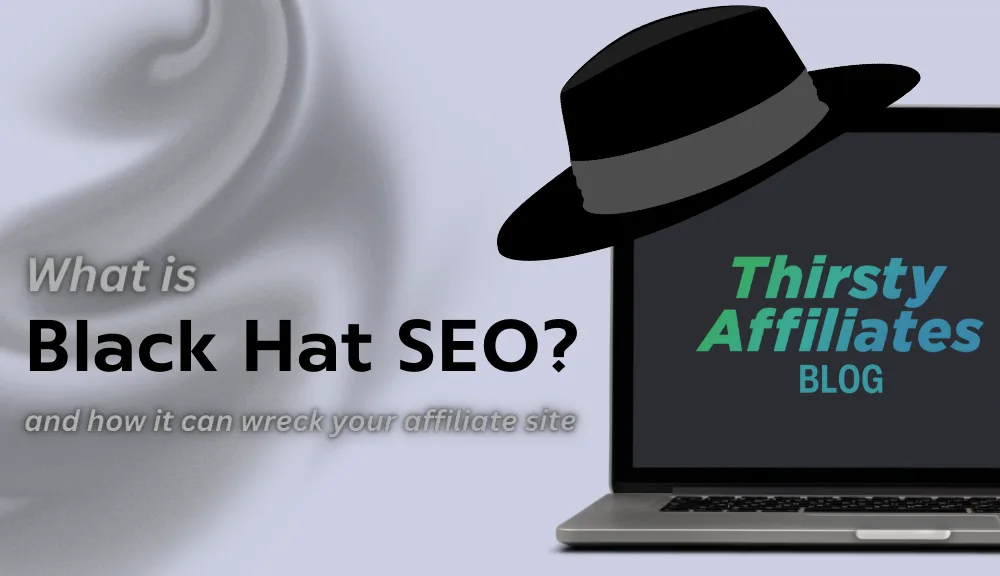
In a world dominated by search engines, understanding the nuances of SEO is crucial for affiliate marketers. While search engine optimization is a powerful tool for enhancing your site's visibility, not all strategies are created equal.
Enter the dark side of SEO: black hat techniques.
These unethical practices promise quick wins but carry significant risks that can wreak havoc on your affiliate site.
In this article, we'll expose 5 black hat SEO techniques that pose a threat to your affiliate site's success. From keyword stuffing to playing hide-and-seek with affiliate links, we'll explore the deceptive tactics used to try and trick search engine algorithms and boost rankings artificially.
But fear not! We won't leave you in the dark. We'll also provide actionable insights on how to steer clear of these treacherous practices and safeguard your site's reputation.
What's the Difference Between White Hat vs Black Hat SEO?
To effectively navigate the world of search engine optimization, it's crucial to have a clear understanding between white hat and black hat tactics.

Think of white hat SEO as the good guy and black hat SEO as the bad guy in the world of website optimization.
White hat SEO focuses on optimizing a website through ethical means and in accordance with search engine guidelines. This involves creating high-quality content, using relevant keywords, optimizing meta tags, improving site speed, and building backlinks through legitimate means such as guest posting and content marketing.
White hat techniques aim to improve a website's visibility in search engine results pages (SERPs) in a sustainable and long-term manner.
On the other hand, black hat SEO employs deceptive and unethical tactics to manipulate search engine algorithms for quick but short-term gains. These tactics include keyword stuffing, hidden text, and link farming.
While black hat techniques may initially boost a website's ranking, they often result in penalties from search engines once detected, leading to decreased visibility or even deindexing from SERPs.
Did You Know… The term “black hat” originated from the black hats that villains often wore in old movies, symbolizing techniques that are meant to cheat the system and manipulate search engine rankings.
Another key difference is the focus on user experience. White hat SEO prioritizes creating valuable content and delivering a positive user experience, aiming to satisfy the needs of website visitors. In contrast, black hat SEO often sacrifices user experience in favor of achieving higher rankings through manipulative tactics.
Blurred Lines: What is Grey Hat SEO?
Some marketers find middle ground with gray hat SEO. Gray hat SEO borrows some tactics from the dark side, without fully crossing the line. It's like bending the rules just a bit while still keeping things ethical.
In summary, white hat SEO is about playing it safe, black hat SEO is a more risky business, and gray hat SEO sits somewhere in the middle. Just remember, opting for white hat techniques is often the best bet for long-term success without risking any penalties from search engines.
How Search Engines Judge Your Content
Ever wonder how search engines decide which websites rank higher in their results? It's a game of algorithms.
By understanding these factors, you can optimize your content to improve your website's visibility in search engine results and attract more organic traffic.
Let's break down how search engines judge your content and how white hat vs black hat tactics play into the mix.
- Relevance. Search engines assess the relevance of your content to the search queries entered by users. The more relevant your content is, the higher your website is likely to rank.
Both white hat and black hat SEO aim for relevance, but the methods differ. White hat SEO focuses on providing genuine, helpful content that matches user queries, while black hat tactics might involve keyword stuffing or irrelevant content to manipulate rankings.
- Originality. Duplicate or plagiarized content is frowned upon and can result in penalties. Creating unique and original content not only helps with SEO but also establishes your website as a credible source of information.
White hat SEO prioritizes originality, encouraging creators to craft unique, valuable content. In contrast, black hat techniques might involve copying or spinning content from other sources, risking penalties from search engines.
- User Experience. Factors such as page load speed, mobile-friendliness, and easy navigation are also taken into account. A website that offers a smooth and enjoyable user experience is more likely to rank higher in search results.
White hat SEO emphasizes a positive user experience, with fast loading times, mobile-friendly designs, and easy navigation. Black hat tactics might sacrifice user experience for quick gains, such as by using intrusive pop-ups or deceptive practices.
- Authority. Websites that are perceived as authoritative, trustworthy, and reliable are more likely to rank higher. Building your website's authority through reputable backlinks, social signals, and expert content can help improve your SEO.
White hat SEO builds authority organically through quality backlinks, expert content, and positive social signals. Black hat methods might attempt to manipulate authority by purchasing links or using other shady tactics.
- Engagement. Engaging and compelling content that keeps users on your website and encourages them to interact with your content can improve your website's SEO performance.
White hat SEO aims to engage users with compelling, relevant content that encourages interaction. Black hat techniques might resort to clickbait or spammy tactics to artificially boost engagement.
In the end, search engines reward white hat tactics that prioritize user satisfaction and ethical practices, while black hat tactics risk penalties and damage to your site's reputation. It's a choice between playing by the rules for sustainable success or taking shortcuts with uncertain consequences.
5 Black Hat Tactics You Might Be Using (and How to Avoid Them)
It's worth noting that not all black hat SEO practices are intentionally malicious. In fact, you might inadvertently be employing some of these techniques without even realizing it.
Regardless of your intentions, it's vital to educate yourself about black hat tactics and take proactive measures to steer clear of them. After all, they can have unfavorable effects on your website's search engine rankings.
1. Keyword Stuffing
Keyword stuffing is a black hat SEO tactic that involves overloading a webpage or content with an excessive number of keywords in an attempt to manipulate search engine rankings. This typically involves inserting keywords repeatedly, unnaturally, and out of context, without providing any meaningful or valuable content to users.
For example, let's say you have a website that sells hiking gear, and you want to optimize your content for the keyword “best hiking boots.”
Instead of creating high-quality content that provides valuable information about hiking boots, you might resort to keyword stuffing by repeatedly using the keyword “best hiking boots” in every sentence or even multiple times within a single paragraph.
This creates content that feels artificial, spammy, and difficult for users to digest:
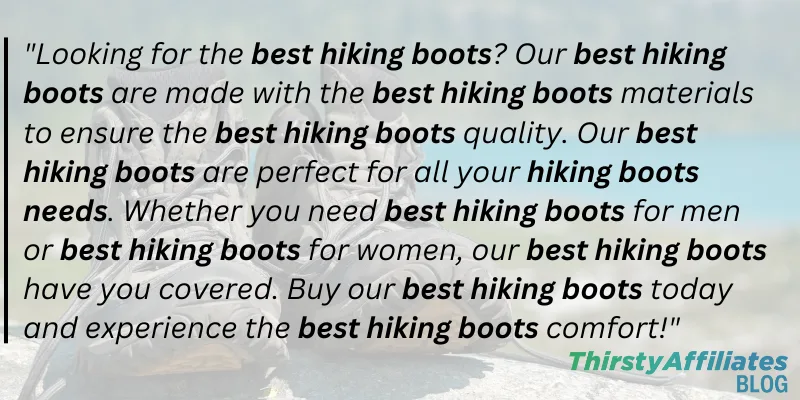
In the example above, “best hiking boots” is excessively repeated, detracting from the content's readability and user value. Search engines frown upon that and will penalize websites with lower rankings or remove them from search results.
Keyword stuffing is a black hat SEO method to be avoided. Instead, focus on creating quality, user-centric content that naturally integrates relevant keywords, ensuring a positive user experience and enhancing your website's SEO effectiveness.
Affiliate Link Overload
Like keyword stuffing, you also want to make sure to avoid cramming too many affiliate links into your content. Not only can this turn off your readers, but it can also raise red flags with search engines.
Luckily, there's a handy tool called ThirstyAffiliate's autolinker that can help you out.
With this feature, you can easily control how many times an affiliate link shows up in your content. So, you can keep your articles informative and fun without bombarding your audience with too many promotions.
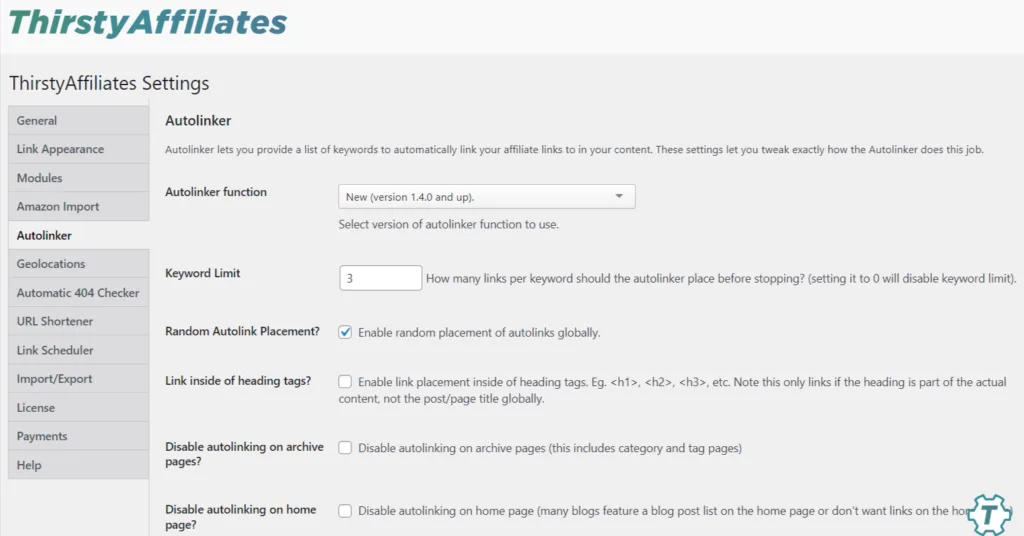
It's all about finding that sweet spot between sharing great products and keeping your content engaging for your readers.
2. Clickbank Titles
Clickbait titles are attention-grabbing headlines designed to entice users to click on a particular piece of content. These titles often employ sensational language, curiosity gaps, or incomplete information to pique curiosity and compel users to find out more.
While they can generate high click-through rates, clickbait is often criticized for misleading users and failing to deliver on the promised content.
They often leave you with a bit of a cliffhanger, like teasing you with just enough info to make you want more. For example, a clickbait title might read, “You won't believe what happened next!” or “This simple trick will change your life!”

At their best, clickbait titles serve as gateways to engaging and valuable content, drawing readers in with promises of intrigue and excitement. They compel users to dive deeper into blog articles, videos, or podcasts, eager to uncover the secrets or insights teased by the headline.
As an affiliate marketer, there's a certain satisfaction in knowing that your words have captivated an audience and enticed them to explore further. However, there's also a responsibility that comes with creating clickbait titles.
Your content must live up to the expectations set by the headline. Misleading or exaggerated titles can erode trust and credibility, ultimately driving readers away rather than drawing them in.
Ultimately, you want to strike a balance between crafting enticing clickbait titles that capture attention and delivering substantive content that provides value to your audience. It's a delicate dance, but when done right, it can lead to meaningful engagement and connection with readers.
3. Abusing Anchor Text
Another practice to be wary of is the excessive use of anchor text. Anchor text refers to the clickable words or phrases that hyperlink to other content, and it plays a crucial role in link building strategies.
While incorporating links in your content can be beneficial for directing users to relevant information, it's vital to use them sensibly and avoid engaging in spammy practices.
One common spammy tactic involves using the exact same anchor text for multiple links, similar to keyword stuffing. This can significantly compromise your site's SEO performance.
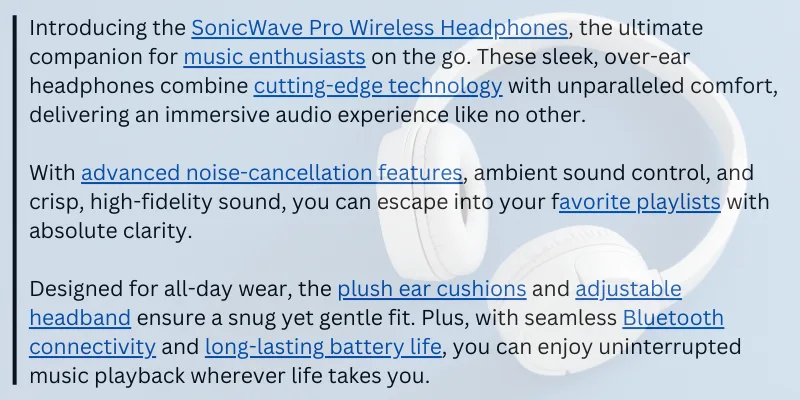
Particularly for affiliate marketers, maintaining a positive reputation is paramount. If your site seems spammy or loaded with sketchy links, it could seriously hurt how people see your brand.
To steer clear of this black hat technique, ensure that your links are relevant and lead to reputable sources. Before adding a link, consider whether it genuinely enhances the value for your visitors.
Furthermore, diversifying your anchor text is crucial. Repeatedly utilizing the same phrases can give off an unnatural vibe. By varying your anchor text, you'll establish a more organic linking structure and elevate the overall quality of your content.
Ultimately, prioritizing quality over quantity is key when it comes to linking. Always focus on delivering an exceptional user experience and upholding the integrity of your brand.
4. Copied Content
Copied content is another SEO killer. Remember back in school when plagiarism was a big deal? Well, it's sort of the same deal here.
Duplicate content can seriously mess with your website's search engine rankings, just like copying someone else's work could land you in the principal's office.

Some website owners knowingly copy text from other sites, which is clearly a bad practice. But even if you're not doing it on purpose, search engine algorithms can still catch you out.
For instance, if you have multiple pages on your site that contain the same or similar text, they may be considered duplicates. This can happen when you have different versions of your website, such as one with the “www” extension and another without, or a separate version for mobile and desktop users.
To dodge this mess, you can use what's called “canonical links“. These little helpers basically tell search engines when you've got duplicate content on purpose. It's like giving a friendly nod to say, “Hey, search engines, I'm on top of this!”
5. Hidden Links
Finally, invisible links are extremely shady in the worlds of both black hat SEO and affiliate marketing. This involves hiding text or links within a webpage's content, making them invisible to users but still detectable by search engine bots.
This is often done by using tricks like setting the text color to match the background or using tiny font sizes.
The goal here is to game the system and boost search engine rankings artificially. By stuffing hidden keywords or links into a webpage, the hope is to trick search engines into thinking the page is more relevant or authoritative than it actually is.
But here's the catch: search engines aren't fooled that easily. They've gotten pretty good at sniffing out these sneaky tactics. Plus, they have strict guidelines against this kind of trickery.
And let's not forget about the users. Hiding text and links is downright deceptive. It undermines their trust and can lead to a frustrating browsing experience. Plus, it's just not cool.
To ensure transparency in affiliate marketing, tools like ThirstyAffiliate Product Displays offer the option to include affiliate disclosures, ensuring readers are always aware of affiliate links within the content.
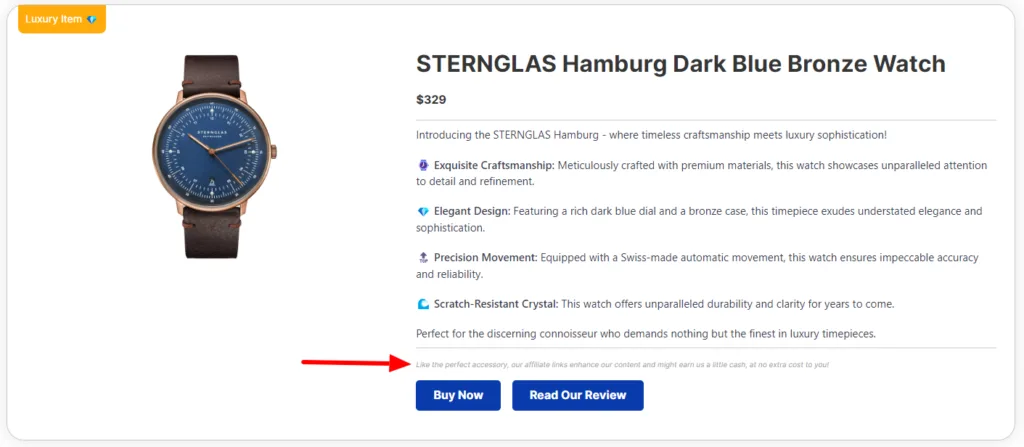
This commitment to transparency helps maintain trust with the audience and fosters a positive user experience.
Conclusion
The success of your affiliate website hinges on implementing effective SEO techniques. After all, a higher SEO ranking means your affiliate site's content gets more eyeballs, making it easier for users to stumble upon it.
In this article, we covered the differences between white hat vs black hat SEO, especially when it comes to your content. To keep your SEO strategy on point and above board, stick to the white hat approach. That means steering clear of these shady black hat moves:
- Don't overstuff your content with keywords: Avoid ruining your awesome content by cramming it full of keywords. Keep it natural and readable by integrating keywords seamlessly into your text.
- Be cautious with anchor text: While links are fantastic for directing traffic, resist the temptation to go overboard with anchor text. Too many links can overwhelm your readers. Keep it balanced, and your audience will appreciate it.
- Stay original and creative: Resist the urge to copy content. Be original, be creative. Your audience craves fresh, unique content, not recycled material they've encountered countless times before.
- Avoid clickbait titles: Steer clear of clickbait titles that promise more than they deliver. Deceptive titles can damage your credibility and alienate your audience.
- Say no to hidden links: Hidden links are deceptive and can lead to penalties from search engines. Instead, focus on transparent linking practices that enhance the user experience.
Want to learn more about staying away from black hat SEO? Feel free to pick our brains in the comments section!
If you liked this post, be sure to follow us on Twitter, Instagram, Facebook, Pinterest, and LinkedIn! And don't forget to subscribe to our newsletter!



Hi Brian, thank you for this amazing post, it is really helpful! You always come with something that is unique and worth reading.
Yes, You are absolutely right. When you want to rank In google, you need to do off-page SEO. but if you do that by black hat SEO Your site can be affected by google penalty ।
Thanks for the pointers. I’ve just started a skincare blog and I’m trying to get more organic traffic. I’ll definitely steer clear of the concepts you mentioned.
Using black hat techniques such as cloaking, link schemes, and keyword stuffing can harm your affiliate site by resulting in lower search engine rankings, penalties, and even permanent deindexing. This can lead to a loss of traffic, revenue, and damage to your reputation.
Thanks for this informative post on the dangers of using black hat techniques on affiliate sites. It’s important for all site owners to prioritize ethical and sustainable SEO practices to avoid long-term negative consequences.
I think it’s all about the backlink game.
Black hat SEO should be avoided at all costs. Instead, focus on approved methods such as guest blog posting, creating a table of contents chart in articles for your readers, striving for a keyword density of 1-2%, and linking to internal pages on your site that have value to your readers.
Thanks for this informative post on the dangers of using black hat techniques on affiliate sites. It’s important for all site owners to prioritize ethical and sustainable SEO practices to avoid long-term negative consequences.
Regards: Glitz Cleaner
Search Engine Penalties: Black hat techniques can lead to search engine penalties, hurting your site’s visibility and ultimately traffic.
Damaged Reputation: Using unethical tactics can damage your brand’s reputation and credibility, leading to distrust among customers and peers.
Legal Issues: Some black hat techniques can be illegal, leading to legal consequences and potentially shutting down your affiliate site.
Thanks for highlighting the dangers of black hat techniques in affiliate marketing. It’s important to stay ethical and use white hat strategies to avoid penalties from search engines. Your article serves as a helpful reminder for affiliate marketers to stay on the right path.
That is an interesting point of view
Absolutely crucial to highlight the dangers of black hat techniques for affiliate sites. The risk of search engine penalties and reputation damage is immense. It’s essential to prioritize ethical and sustainable strategies for long-term success. Thanks for shedding light on this important topic!
It’s important to prioritize long-term success by focusing on white hat SEO strategies that comply with search engine guidelines. By building high-quality backlinks, fostering genuine relationships, and creating valuable content, you can enhance your site’s authority and reputation without risking penalties.
Thank you for highlighting the importance of maintaining ethical practices in off-page SEO. It’s crucial for all affiliate marketers to prioritize sustainable strategies that align with search engine regulations for long-term success.
Thank you for this enlightening article on the risks associated with utilising black hat strategies on affiliate websites. To avoid long-term negative effects, it’s critical for all website owners to give ethical and sustainable SEO practises top priority.
I have read about black hat seo earlier but i could not understand it then .but after reading this article i understand this thanks for the knowledge
I will definatetly avoid these things from now on
How much does amazon pays for each affiliate sell done through my link?
I have read about black hat seo earlier but i could not understand it then .